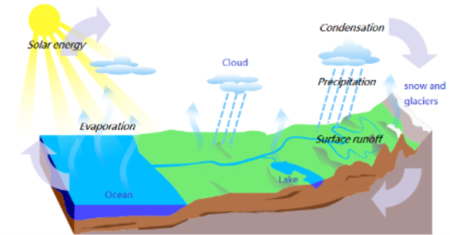- Science
- Grade 4
- Earth and space
Science.4.10.A
describe and illustrate the continuous movement of water above and on the surface of Earth through the water cycle and explain the role of the Sun as a major source of energy in this process;

Knowledge and Skills Statement
The further explanation is designed to be a resource for educators that helps them better understand the topic their students are learning. Further explanations may be written at a more complex level than would be expected for students at the grade level.
The water cycle on the surface of the Earth includes: evaporation, condensation, precipitation, and run-off. Although groundwater is depicted in this image, it is covered in grade 7 and transpiration is discussed in grade 8.
Research
Keeley, Page. “Formative Assessment Probes: Uncovering Representations of the Water Cycle.” Science and Children 55, no. 5 (January 2018): 18-19.
http://www.jstor.org/stable/44709896.
Summary: Formative Assessments should be used to guide instruction based on results. This formative assessment probe focuses on one common misconception that students have about the water cycle. This misconception is caused by the water cycle representations they see in books, on posters, and online. Most of the pictures of the water cycle we see have a large or surface body of water, leading students to believe a water cycle diagram must include the ocean or another body of water like a lake or river. Students should know that the water cycle includes evaporation, condensation, and precipitation. Although diagrams including a surface body of water are correct, these can lead students to believe that water only evaporates from these water sources. Evaporated water can come from the soil, animal waste, or plant transpiration. After using the formative assessment to see what the class knows about evaporation in the water cycle, teachers should guide them in identifying various sources that water can evaporate from and have them draw the water cycle using one of those sources.

